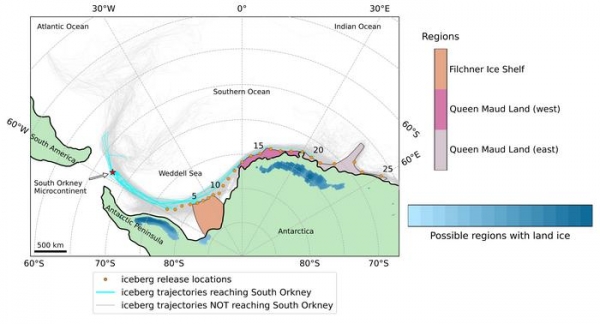It is no strange sight to see icebergs break off of the Antarctic ice cap and drift away, like the gigantic sheet of ice that is currently heading for the island of South Georgia. But climate change is making it happen more frequently, with ever-larger icebergs in the waters around Antarctica. Researchers from Utrecht University are studying the routes that icebergs followed during geological periods of rapid ice cap deterioration, such as the ends of ice ages. That provides crucial information about the effect of melting icebergs and its consequences for the future. In the process, they also found an explanation for the mysterious discovery of ancient material from Antarctica near South Orkney, an island to the southwest of South Georgia.
Ice caps grow as snow falls on the top and gravity pulls them slowly towards the sea. There, they lose large quantities of ice via melting and calving of icebergs. If the ice cap growth keeps pace with loss at the edges, then it remains in balance and stays the same size. But as the air and ocean around the south pole have warmed over the past few decades, icebergs calve off faster and more often: the meltwater on the ice cap weakens the sheet of ice, and the warmer ocean makes the ice sheets thinner. As a result, enormous ice blocks can break up into massive icebergs in a short amount of time.
Puzzle
The seas around South Georgia have a long history of iceberg research. The island is in the middle of waters that researchers call ‘Iceberg Alley’: a narrow strip of ocean full of icebergs that have calved off of the Antarctic ice cap, then pushed north by wind and water until they reach warmer seas and melt away entirely. Since Antarctica has had a large ice cap for around 34 million years, the remote islands around Iceberg Alley have seen countless icebergs pass by. South Orkney is one of these islands, and scientists have found that it preserves evidence of icebergs from even before the ice cap was formed 34 million years ago. The discovery had long puzzled researchers, because in 2017 they found fragments of debris that originated in Antarctica. The only way for the debris to travel all the way to South Orkney is via icebergs: the icebergs also contain large amounts of stone fragments that glaciers had broken off of the Antarctic continent. When the iceberg melts, the debris sinks to the ocean floor.
Read more at Utrecht University
Image: Results of the Master’s thesis research that was published in Climate of the Past. The red star indicates the position of South Orkney during the late Eocene (37 million years ago). The blue regions indicate where Antarctica may have had land ice at the time. The grey and light-blue lines in the ocean show the possible paths of icebergs. Light blue paths actually reached South Orkney, which was in Iceberg Alley in the late Eocene. (Credit: Mark Elbertsen / Climate of the Past)
Sci/Tech Climate Top Stories
